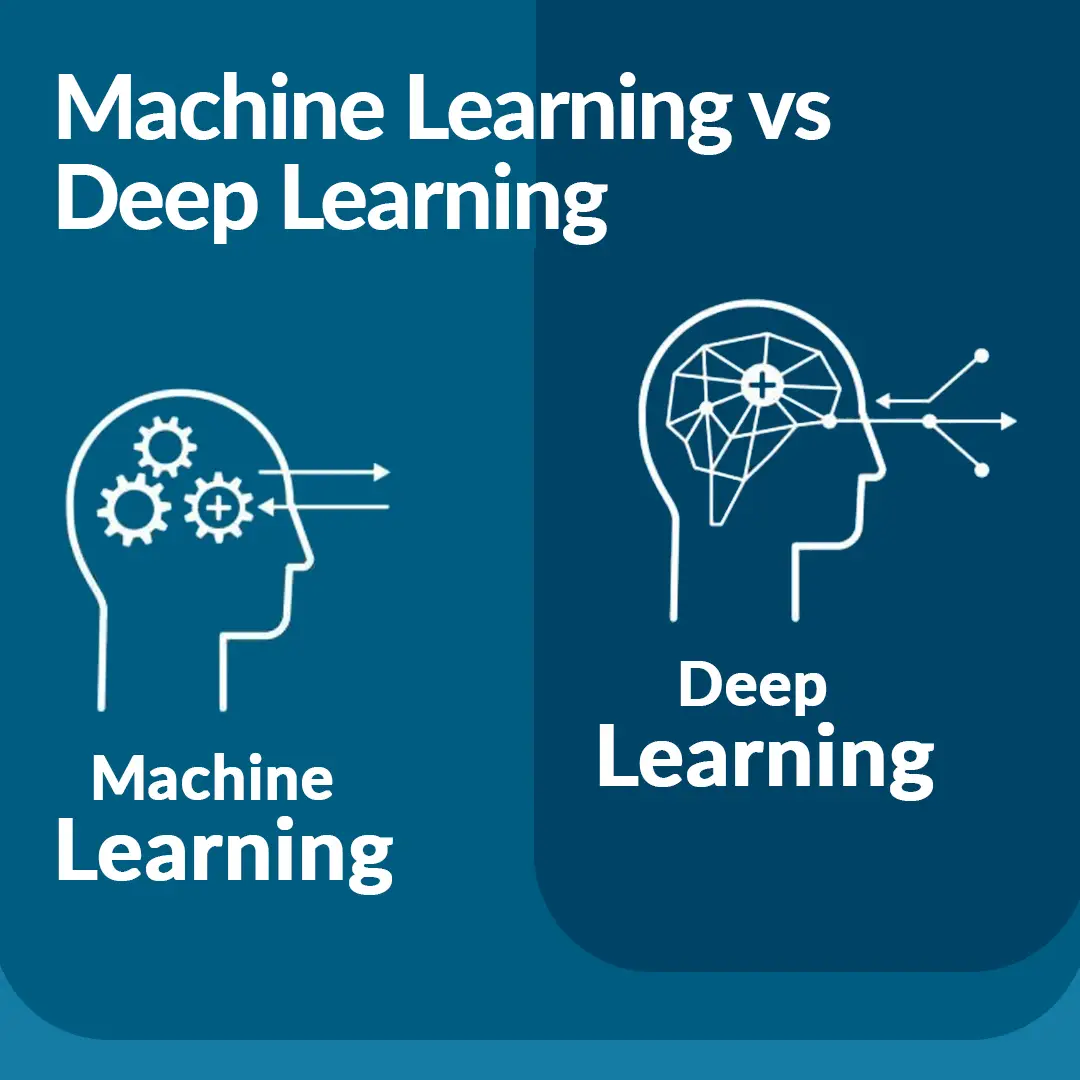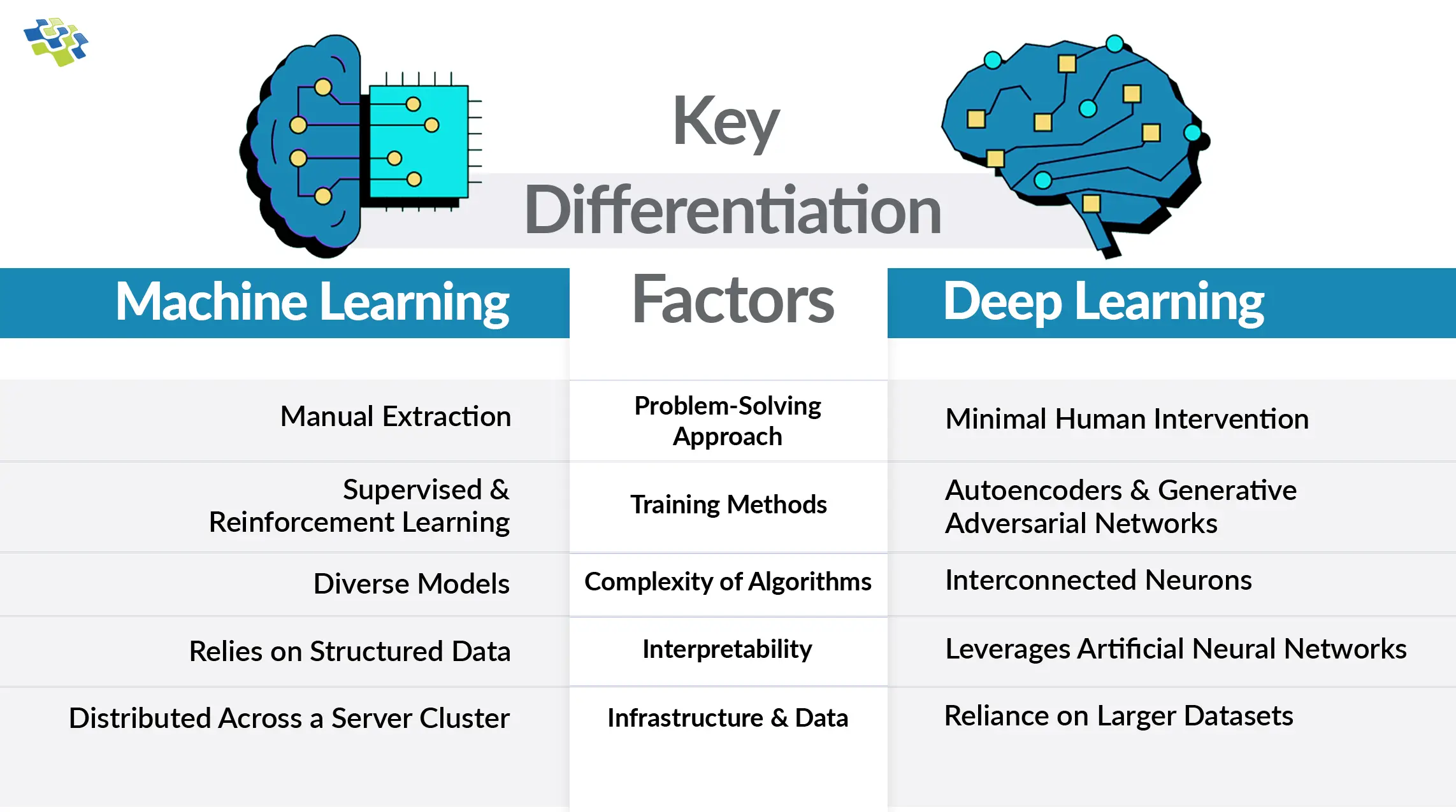The Ultimate Comparison of Machine Learning vs Deep Learning
What exactly are machine and deep learning, which frequently emerge in AI discussions? Machine learning uses algorithms to teach computers how to learn and make predictions, while deep learning is a subset that focuses on neural networks and complex data representations.

“The machine learning market, which encompasses most AI projects and software, is expected to dominate the overall AI market. By 2030, it is anticipated to surge from approximately 140 billion USD to two trillion USD. Furthermore, the deep learning chip market is projected to surpass 21 billion USD by 2027, highlighting significant growth potential.”- Statista
Machine Learning Overview
Machine learning is a subfield of artificial intelligence dedicated to developing statistical models and algorithms that enable computers to learn and make predictions or decisions without explicit programming. It involves training algorithms on extensive datasets to identify correlations and patterns, which are then utilized to forecast outcomes or make determinations when presented with new data. By leveraging these learned patterns, machine learning empowers computers to generalize from past experiences and make accurate predictions or decisions in diverse scenarios.
How does Machine Learning Work?
Machine learning involves the use of complex mathematics and coding to enable computers to perform tasks and improve their performance over time based on provided data. Similar to how a torch automatically switches on in response to the word “dark,” machine learning enables various automated functions in sectors like data security and finance. AI algorithms constantly learn, resembling virtual personal assistants, and excel at their tasks. Deep learning, particularly through deep neural networks, adds an intriguing and thrilling dimension to the process, allowing machines to learn new skills and capabilities.
Deep Learning Overview
Deep learning, a subset of machine learning, explores complex relationships and patterns in data by leveraging neural networks with multiple layers. Inspired by the structure and functioning of the human brain, deep learning exhibits remarkable proficiency across various domains such as speech recognition, computer vision, and natural language processing. Deep learning models are trained using vast amounts of data and algorithms that continuously learn and improve, enabling them to analyze extensive datasets and enhance their accuracy. This adaptive nature allows deep learning models to dynamically adapt to new situations, making them highly suitable for solving intricate real-world problems. By harnessing the power of deep learning, machines can delve deeper into data, unravel intricate patterns, and make increasingly accurate predictions and decisions.
How does Deep Learning Work?
Deep learning models analyze data in a human-like manner using artificial neural networks, composed of layered algorithms. Ensuring accurate conclusions can be challenging, requiring extensive training. However, when successful, deep learning is considered a scientific marvel and a cornerstone of true artificial intelligence. Google’s AlphaGo exemplifies deep learning’s potential by mastering the complex game of Go through competition and self-learning, surpassing prior AI capabilities. Deep learning drives image recognition, voice translation, autonomous vehicles, and various other practical applications.
Further Read: Improving ML Model Performance: 5 Key Steps You Should Follow
Machine Learning Vs Deep Learning: Key Differences
Deep learning and machine learning are distinct technologies within artificial intelligence (AI). While both involve training models on data for predictions, they differ in design, capabilities, and applications. Let’s compare deep learning and machine learning.
1. Problem-Solving Approach
Feature engineering in traditional machine learning involves the manual extraction and selection of relevant features from raw data by human experts, who assign appropriate weights to each feature. This process aims to optimize the performance of machine learning models by enhancing the representation and predictive power of the data.
On the other hand, deep learning automates feature engineering with minimal human intervention. Deep learning models, inspired by the human brain, have intricate neural network architectures. These architectures consist of multiple layers of interconnected nodes, with each node independently assigning weights to the features. Data flows forward through the network, and the model calculates the difference between predicted and actual outputs.
2. Training Methods
Machine learning encompasses various training techniques, including supervised, unsupervised, semi-supervised, and reinforcement learning, as well as self-supervised learning and transfer learning. These approaches allow models to learn from labelled and unlabelled data, combine both types of data, receive rewards for optimal decisions, and leverage pre-existing knowledge. Machine learning involves using algorithms to train models on data and make predictions based on patterns and insights. Techniques such as regression, classification, and clustering are commonly used. However, traditional machine learning models often have limited depth and complexity.
Deep learning algorithms use advanced training techniques to handle complex tasks. They include autoencoders, generative adversarial networks, recurrent neural networks, and convolutional neural networks. These methods employ mathematical backpropagation to adjust network weights, minimizing error and improving prediction accuracy. Deep learning models also incorporate non-linear functions such as exponential and logarithmic to capture intricate patterns in the data. By utilizing these techniques, deep learning surpasses traditional machine learning by uncovering complex dependencies and achieving higher performance and accuracy in predictions.
3. Complexity of Algorithms
Machine learning algorithms encompass a wide range of techniques, not limited to simple and linear approaches. They include diverse models such as decision trees, support vector machines, random forests, and gradient boosting. These algorithms possess varying levels of complexity and non-linearity, allowing them to capture intricate patterns, relationships, and dependencies in data for more accurate predictions and insights.
Deep learning algorithms leverage artificial neural networks, enabling them to handle higher levels of complexity compared to traditional machine learning approaches. By utilizing multiple layers of interconnected neurons, deep learning models can learn hierarchical representations, automatically extract intricate features, and excel at tasks such as image recognition, natural language processing, and speech recognition.
4. Interpretability
Machine learning relies on structured data and active developer engagement to derive meaningful models. With developer involvement in the AI training process, understanding machine learning has become more accessible. Model transparency, smaller datasets, and reduced parameters facilitate a better understanding of the model’s workings and decision-making processes.
Deep learning leverages artificial neural networks to extract knowledge from unstructured inputs like photos, videos, and audio. However, the complexity of these neural networks often makes it challenging for developers to understand the decision-making process of the model. Consequently, deep learning algorithms are commonly called “black box” models.
5. Infrastructure & Data Requirements
Machine learning data and models can be deployed and executed on a single instance or distributed across a server cluster. This flexibility allows for efficient utilization of resources and scalability. Whether it’s running on a single machine or a cluster of servers, machine learning systems can adapt to the computational demands of the task at hand.
Deep learning models, due to their complexity and reliance on larger datasets, necessitate significant storage and computational power compared to traditional machine learning models. Such models often require high-performance clusters and substantial infrastructure. Consequently, the infrastructure demands of deep learning solutions can lead to higher costs compared to traditional machine learning approaches.
Further Read: Machine Learning – Supervised, Unsupervised, & Reinforced Learning
Use Cases of Machine Learning
- Fraud Detection: ML (Machine Learning) algorithms are effective in detecting fraudulent activities by scanning banking accounts for anomalies, enabling the identification of potential fraud cases, and enhancing security measures against financial fraud.
- Product Recommendations: When using platforms like Netflix or online retailers, personalized recommendations are prominently displayed by leveraging machine learning algorithms. These algorithms analyze your past purchases and searches, matching your interests with those of similar users. This information is then utilized to provide tailored and accurate recommendations, highlighting the effectiveness of machine learning in delivering personalized experiences.
- Image Classification: Machine learning models excel in image classification tasks, enabling the identification of various categories like objects, animals, and even facial recognition. By leveraging pattern recognition and feature extraction techniques, these models can accurately categorize and distinguish different visual elements, facilitating applications in areas such as computer vision, autonomous systems, and biometric identification.
- Credit Scoring: ML algorithms can evaluate creditworthiness and forecast default risks by analyzing credit history, financial data, and customer profiles. This enables lenders to make informed decisions on granting credit, setting interest rates, and managing risk, enhancing the efficiency and accuracy of credit assessments in financial institutions.
Use Cases of Deep Learning
- Medical Imaging: Deep learning models excel in analyzing medical images, such as X-rays, CT scans, and MRIs, to automate the process of diagnosis, tumor detection, and disease classification. This capability empowers healthcare professionals with more accurate and efficient tools for medical imaging analysis and enhances patient care.
- Computer Vision: Deep learning algorithms demonstrate high accuracy in object detection, image segmentation, and facial recognition tasks, playing a vital role in applications like self-driving cars and surveillance systems. These algorithms enable precise identification and understanding of visual elements, enhancing safety and security in real-world scenarios.
- Generative Models: Generative adversarial networks (GANs), a type of deep learning architecture, can produce realistic images, audio, or video content. These advancements find valuable applications in fields like art, entertainment, and data augmentation, enabling the generation of novel and lifelike multimedia content.
- Natural Language Processing: Deep learning models exhibit exceptional performance in diverse tasks, including sentiment analysis, language translation, chatbot development, and speech recognition. Leveraging their ability to capture intricate patterns and contextual nuances, these models empower natural language processing applications and enable more accurate and advanced language-based functionalities.
Conclusion
In this ultimate comparison of machine learning vs deep learning, we have explored the strengths and applications of both approaches. Machine learning offers versatility and efficiency in tasks such as image classification, customer segmentation, and credit scoring. Deep learning, with its complex neural networks, excels in areas like natural language processing, computer vision, and medical imaging analysis. By understanding the unique capabilities of each technique, businesses can harness the power of AI to drive innovation and make informed decisions.
At NextGen Invent, we understand the power of both deep learning vs machine learning in revolutionizing industries. Our passionate team of AI experts and developers specializes in harnessing the capabilities of machine learning and deep learning to create transformative AI solutions. Whether you require machine learning algorithms for tasks like image classification and customer segmentation, or deep learning models for natural language processing and computer vision, we have the expertise to deliver innovative applications tailored to your specific needs.
Connect with us to explore how our AI app development services, driven by the latest advancements in machine learning vs deep learning, can revolutionize your industry, drive growth, and propel your business forward.
Stay In the Know
Get Latest updates and industry insights every month.

